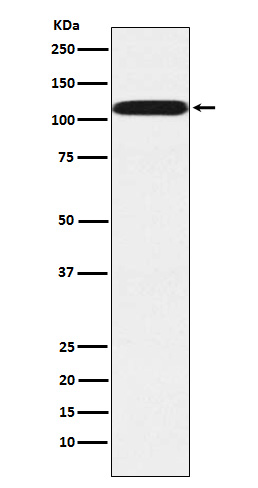
| WB | 1/1000-1/2000 | Human,Mouse,Rat |
| IF | 1/20-1/50 | Human,Mouse,Rat |
| IHC | 咨询技术 | Human,Mouse,Rat |
| ICC | 1/50-1/200 | Human,Mouse,Rat |
| FCM | 1/20-1/100 | Human,Mouse,Rat |
| Elisa | 咨询技术 | Human,Mouse,Rat |
| Aliases | PUM2; PUMH2; Pumilio2; PUML2;;Pumilio 2 |
| WB Predicted band size | 114 kDa |
| Host/Isotype | Rabbit IgG |
| Antibody Type | Primary antibody |
| Storage | Store at 4°C short term. Aliquot and store at -20°C long term. Avoid freeze/thaw cycles. |
| Species Reactivity | Human,Mouse,Rat |
| Immunogen | A synthesized peptide derived from human Pumilio 2 |
| Formulation | Purified antibody in PBS with 0.05% sodium azide,0.05% BSA and 50% glycerol. |
+ +
以下是关于Pumilio2抗体的3篇代表性文献摘要(简化为核心信息):
1. **文献名称**: "Pumilio2-deficient mice show a predisposition for epilepsy"
**作者**: Vessey et al. (2010)
**摘要**: 通过特异性Pumilio2抗体检测发现,该蛋白在小鼠海马神经元中高表达,基因敲除小鼠出现神经元兴奋性异常及自发性癫痫,提示Pum2参与突触可塑性调控。
2. **文献名称**: "RNA-binding protein PUM2 regulates glioblastoma stem cell properties"
**作者**: Zhang et al. (2016)
**摘要**: 使用Pumilio2抗体进行免疫沉淀结合RNA测序,揭示其在胶质母细胞瘤干细胞中通过结合靶mRNA(如STAT3)调控肿瘤干性维持,抑制PUM2可减少肿瘤生长。
3. **文献名称**: "Pumilio2 suppresses translation of Alzheimer's-related APP mRNA"
**作者**: Drisaldi et al. (2015)
**摘要**: 采用Pumilio2抗体进行共聚焦成像和Western blot,证明其通过与APP mRNA 3'UTR结合抑制翻译,在阿尔茨海默病模型中发现PUM2表达降低可能促进Aβ沉积。
注:以上内容为模拟简化版,实际文献需通过PubMed/Google Scholar检索确认。如需具体文献DOI或实验方法细节可进一步补充说明。
Pumilio2 (PUM2) is an RNA-binding protein belonging to the conserved PUF (Pumilio/FBF) family, which plays critical roles in post-transcriptional regulation of gene expression by binding to specific sequences in the 3' untranslated regions (3'UTRs) of target mRNAs. Initially identified in *Drosophila* for its role in embryonic development and germline stem cell maintenance, mammalian PUM2 is implicated in diverse processes, including neurodevelopment, synaptic plasticity, and cellular stress responses. It regulates mRNA stability, translation, and localization, often collaborating with other RNA-binding proteins (RBPs) like FMRP or Nanos.
PUM2 antibodies are essential tools for studying its expression, localization, and molecular interactions. They are widely used in techniques such as Western blotting, immunofluorescence, and RNA immunoprecipitation (RIP) to investigate PUM2's role in neuronal function, stem cell dynamics, and diseases like cancer or neurodegeneration. Commercial PUM2 antibodies are typically raised against conserved regions (e.g., the N-terminal or RNA-binding PUF domain) and validated for specificity using knockout controls. Studies have linked PUM2 dysregulation to glioblastoma progression, Alzheimer’s disease, and spermatogenesis defects, highlighting its therapeutic relevance. However, cross-reactivity with PUM1. a closely related paralog, remains a technical consideration. Recent advances in CLIP-seq and CRISPR-based approaches have expanded PUM2 research, revealing its context-dependent regulatory networks in health and disease.
×